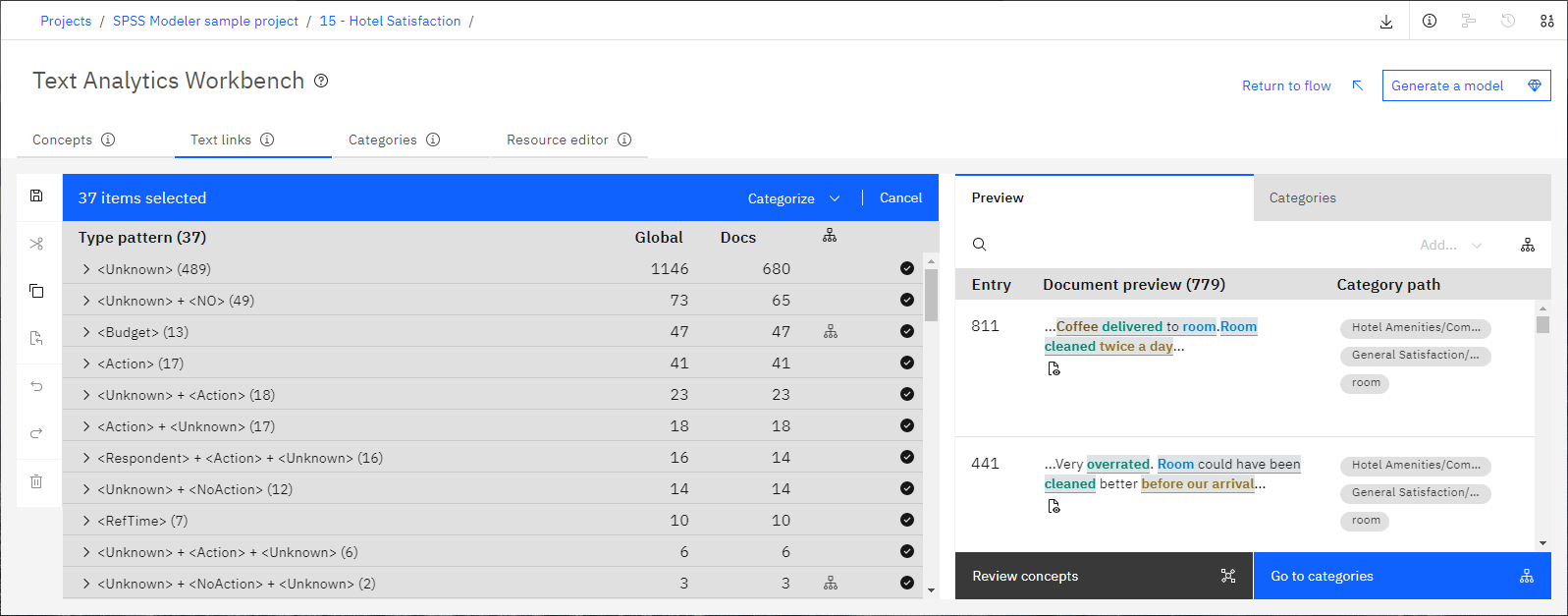Text links tab
Text link analysis (TLA) is a pattern-matching technology. which identifies relationships between the extracted concepts in the text data based on known patterns. SPSS Modeler compares the extracted concepts against TLA rules to see whether the concepts match the specific patterns that are defined in the TLA rules.
On the Text links tab, you can define new rules and explore the text links and patterns that are found in your text data. These terms are defined as follows.
- Patterns
- A pattern is created by combining concepts or types. Patterns can be either concept
patterns or type patterns. Each pattern can have up to six concepts or six
types. Patterns are sometimes referred to as text link analysis (TLA) patterns.
- Type patterns
- Type patterns are shown as combinations of words in angle brackets:
<Organization> + <Location> + <Positive>
- Concept patterns
- Concept patterns appear as combinations of words without brackets:
atmosphere + pleasant + hotel
Patterns are most useful when you want to discover opinions about a particular subject or relationships between concepts.
For example, extracting a product name from a customer review might not be interesting to you. Instead, you can look at the extracted patterns to see whether you can find examples where a document or record expresses an opinion that the product is good, bad, or expensive. You might want to also extract opinions on products from survey data, or relationships between people or places from intelligence data.
- Rules
- Rules define type patterns. The text link analysis compares the text data against these rules during the pattern matching phase of the extraction process. When the text matches a type pattern, the information is extracted as a pattern. These rules are defined in the linguistic resources, such as a template or text analysis package (TAP). Rules are sometimes referred to as text link analysis (TLA) rules or TLA pattern rules.
- Text links
- Text links show where in the text data a concept or pattern appears.
To use TLA, you must have linguistic resources that contain a template with some TLA rules defined. When you select a template, you can identify which templates have rules by whether they have an icon in the TLA column.

How the pattern rule is defined in the linguistic resources dictates the complexity of your pattern results. You can refine the rules to adapt them to your particular needs in the Resource editor tab. After you explore the patterns, you can add them to categories.
Type pattern pane
You can explore and select patterns from your extraction results with the
Type pattern pane. Patterns are first grouped into type patterns, which are
combinations of related types that match a rule. However, sometimes a single type matches a rule.
Then concept patterns are grouped under the type patterns that they fit. For example, the concept
patterns price + highcost + too much<Budget> + <Negative>
You can click the Filter icon to filter the type patterns that are displayed or search for specific concepts by clicking the Search icon.
To change how patterns are extracted, click the Settings icon with no type patterns selected. For more information about the settings, see Setting options.
Preview pane
If you want to see how a pattern appears in the document that has the pattern, select a pattern in the Type pattern pane. The Preview pane updates to show it. The concepts are highlighted to help you easily identify them in the text.
Categories pane
The Categories pane shows the structure of your category model. The hierarchy shows how patterns are categorized. The Categories pane shows the type patterns in your category model and the rules that are used to categorize concept patterns. Any concept patterns that were added to your category model appear as text links.